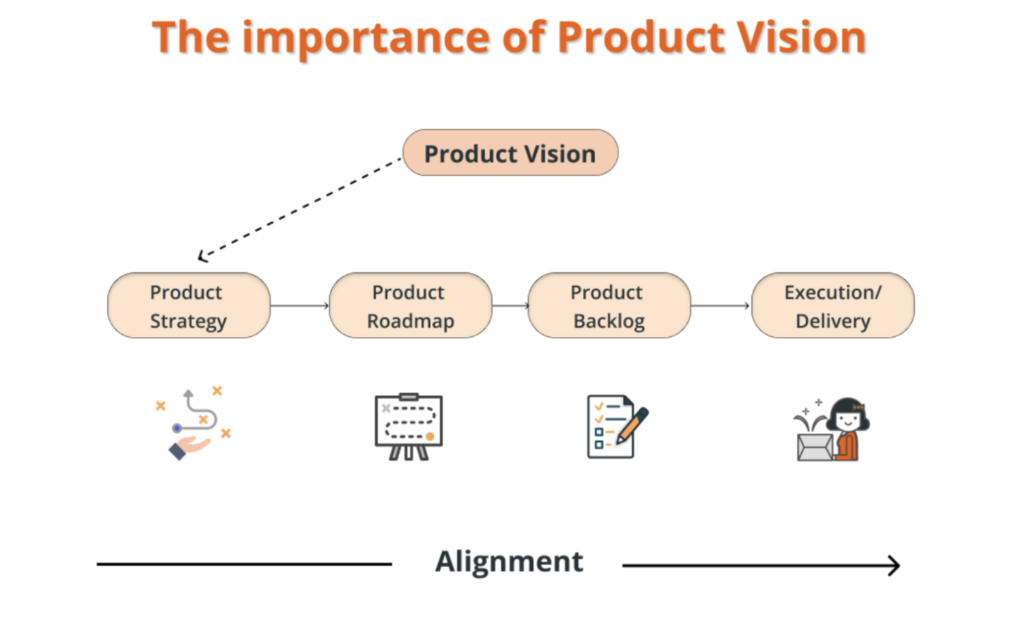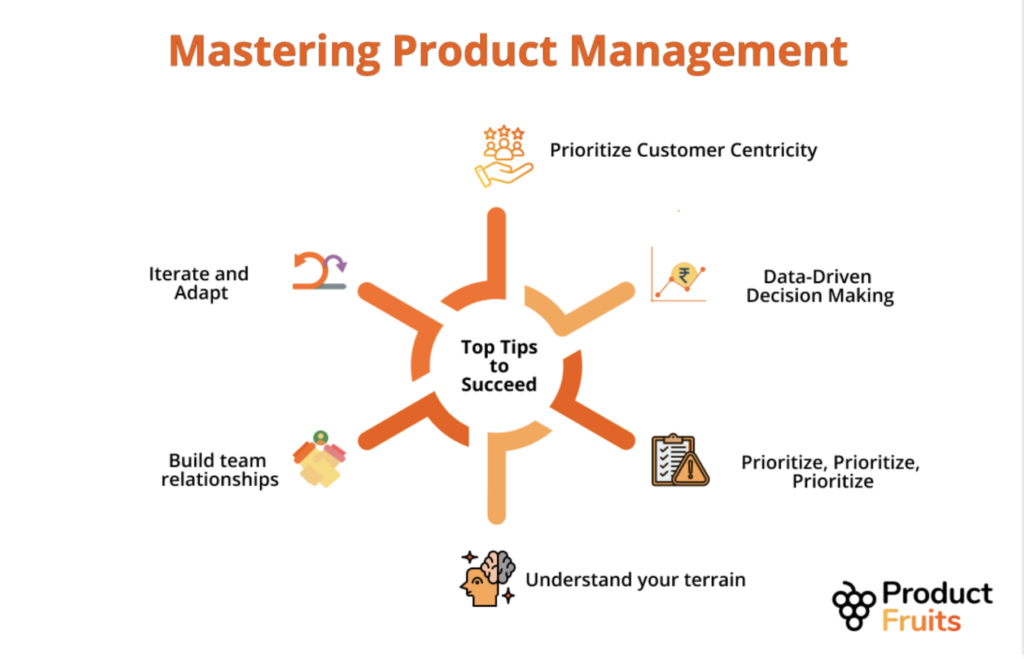In the dynamic world of product management, a product manager takes center stage as the orchestrator of a complex and multifaceted process. They are the visionaries, the strategists, and the navigators of a product’s journey from conception to realization.
Let’s understand who a product manager is, and what they actually do.
Who is a product manager?
A product manager is a professional who monitors the progress and execution of a product.
They determine the goal of the product, carry market research, and create strategic plans.
The real value and expertise of a Product manager comes with their ability to collaborate with cross-functional teams and oversee the product’s development, ensuring it aligns with business goals and customer needs.
In a nutshell, product managers are responsible for development, design, delivery and further growth of the product.
Product manager vs Product Owner
Product managers play a pivotal role in product’s future development as they serve as strategists who determine the overall trajectory of the product. They ensure that the product not only meets the end user needs but also flows smoothly into the stated objectives of the business.
On the contrary, product owners are those individuals who work every day to ensure the success of their product. They diligently supervise the team in executing the strategic plan provided by the product manager. This is done by attentively monitoring and prioritizing work.
- SCOPE OF RESPONSIBILITY
Product owner is responsible for nitty-gritty details while creating new products. They engage closely together with the development team to guarantee that the tasks are scheduled, prioritized and finished in a timely manner.
The product manager is in charge of the products whole lifecycle, from ideation to launch.
- DECISION MAKING
The product manager makes general choices that affect the performance of the whole product. This includes determining how to make profits and increase customer engagement, while the product owner deals with the decisions related to details of the project.
- SKILLS
Product managers possess strong organizational skills and must pay attention to minute details. On the other hand, product owners need to possess a combination of technical skills, research skills, and business acumen to understand the market.
- RESPONSIBILITY
Product managers supervise the overall performance and economic viability of the product, whilst product owners guarantee that features and customer experiences are defined to satisfy customers.
- BUSINESS STRATEGY
Product managers drive the product on a trajectory that aligns with market positioning. On the other hand,are responsible to carry out the plans by adding specific features and functionalities to meet the defined objectives set by the product manager.
Responsibilities of a product manager
Here are a few key responsibilities that a product manager is required to assume.
1. Outline product vision and strategy
A product manager is the architect of the product’s vision. The product vision represents the ultimate objective the team aims to accomplish. It offers the product team a glimpse into the future product vision and aligns their efforts.
A product manager also sets a high level plan that helps the team achieve this vision. The product manager defines:
- What the product is
- What it does
- Why it matters
It is the product manager who is responsible to form the product vision, create a strategy to achieve it, and keep in mind the customer and organizational needs.
“Be stubborn on vision but flexible on the detail.” – Jeff Bezos, CEO, Amazon

2. Define releases
The timing and the content of the product releases is determined by the product manager. The product manager plays a pivotal role in deciding what features should be introduced in a particular release or what feature improvements to prioritize.
These decisions are based on customer needs, market conditions, organizational objectives, and the product’s development cycle.
3. Evaluate ideas
Product manager keeps a vigilant watch on market dynamics and the competitive landscape. The goal is to use insights from customer feedback and data analysis to identify valuable ideas.
Each proposed concept undergoes a meticulous assessment. This helps define a concept feasibility and potential product value impact
4. Prioritize features
In the world of product development, time and resources are often very limited. The job of the project manager is to prioritize each feature launch or enhancement in a way that the customer issues are resolved, the product remains sticky, and the organizational goals are met efficiently.
5. Build a product roadmap
“Roadmaps are evidence of strategy. Not a list of features”. – Steve Johnson, COO, Vidyard
A product roadmap is a strategic visual document that represents the development and evolution of the product.
This roadmap helps the product manager communicate an elaborate plan to the key internal stakeholders of the product. It acts like a communication tool that keeps all the involved teams on the same page.
The product roadmap acts as a compass, guiding the way with clear timelines for releases, clearly indicating the interdependencies on internal teams, and a dynamic progress tracker. It is the linchpin that keeps the orchestra of product development in sync.
6. Analyze progress
The product manager keeps a close watch on market performance.
An in-depth analysis of the product’s progress is conducted with metrics like user engagement, conversion rates, revenue and churn rate. Product managers rely on data to steer the product in the right direction by addressing pain points and capitalizing on the strengths of the products.
Mastering Product Management: Top Tips to Succeed
A skilled product manager can increase company profits by 34.2%. Here are some tips that can help you master the art of product management.
1. Prioritize customer centricity
When it comes to your product, the customer is king.
The success of a product depends on how much customers like it, how long they stick with it, and how happy they are with it.
A good product manager has a deep sense of understanding of the customer’s needs and preferences. It is the job of the product manager to get customer feedback, uncover opportunities, get a better understanding of customer pain points and drive success of the product.
The product should be built around customer pain points ensuring increased customer loyalty and satisfactions.
2. Data-Driven Decision-Making
Product managers are entrusted with the responsibility of making informed decisions rooted in concrete data and statistics. Relying solely on assumptions is misleading and can lead to misalignment between customer needs and product value.
Product managers need to feel confident to validate their assumptions with data from credible sources and subject them to thorough analysis.
By harnessing the power of data analytics, user behavior metrics, and market research, product managers gain valuable insights into user preferences, market trends, and the competitive landscape, empowering them to make well-founded decisions that drive product success.
3. Prioritize, Prioritize, Prioritize
The essence of strategy is choosing what not to do. – Michael Porterer
At the core of effective product management lies the art of prioritization. Product managers are tasked with a multitude of decisions: from determining which bugs to address first, to identifying necessary enhancements, and pinpointing the most crucial features to release.
Each of these choices is made with careful consideration of a complex web of factors, including budgetary constraints, incentives, customer concerns, and stakeholder input.
In this ever-evolving landscape, product managers are akin to strategic architects, building a product blueprint by deliberately excluding choices that don’t align with the broader vision.
4. Understand your terrain
Product managers need to have a deep understanding of the industry. They need to keep a pulse on its dynamic trends, and the principal competitors within the market landscape. Equally crucial is a deep understanding of the pain points experienced by consumers and their financial capacity.
Fruity Tip: As a product manager, you should talk to as many customers and stakeholders as possible. Ask relevant questions about the consumer experience, problems the product is solving and the problems that remain unsolved.
5. Build team relationships
The quality of internal team communication can build or break a product team. A product manager deals with a complex mix of stakeholders, each with a different set of expertise and language they understand best.
Product managers need to be masters of communication. They need to be able to relay information to different teams, centralize efforts and objectives, and keep all stakeholders in the loop at all times.
6. Iterate and Adapt
Continuous improvement is the key to the sustained success of the product. A masterful product manager makes a relentless commitment to evolution and understanding.
The product manager has to develop a thick skin and collect as many relevant reviews of the product as possible. Every suggestion, critique, or request is an opportunity to refine and advance the product.

Challenges faced by a Product Manager
Product managers often face a number of challenges. A few of them are as follows:
Communication across cross-functional teams
Product managers have claimed that they spend the majority of their time collaborating with technical and design teams, and defining the product strategy.
Often, product managers face challenges in maintaining a clear flow of communication across different teams in an organization. Knowledge hoarding and sluggish communication within siloed teams significantly impact the product manager’s ability to meet objectives.
A product team includes individuals tasked with diverse functions, including UX designers, developers, testers, and engineers. The product manager needs to facilitate communication and understanding between each roleThis communication and team alignment are crucial for achieving the desired results.
Product adoption and onboarding
Acquiring users is easy, retaining them is the tough part. Product managers need to have the expertise and know-how to create a smooth onboarding flow so that users immediately realize the value of the product. This moment of realization is what helps the company retain its users, ensuring a healthier bottom line.
Keeping up with the tech trends
Keeping pace with the rapidly evolving tech landscape can be a significant challenge for product managers. It’s essential for them to remain well-informed about the latest technological developments and industry insights, particularly those relevant to their customer base.
A highly effective strategy for addressing this challenge involves cultivating a tech-savvy culture within the organization. This entails fostering an environment where team members are not only encouraged but also enthusiastic about sharing their insights regarding various tech news, emerging trends, and comprehensive reports that directly impact the organization’s customer base.
Understanding product fit and future
Assessing product-market fit and forecasting a product’s future trajectory are demanding tasks. As a product manager you should have a basic assessment of where the product would be in one week, month, or year.
Product managers must continuously refine their understanding of their target audience, market dynamics, and changing customer needs to ensure that their product remains relevant and competitive.
Establishing a feedback mechanism
A solid feedback loop is key for product development. Gathering feedback from a variety of sources, including users, stakeholders, and internal teams, is essential to drive informed product development.
This task involves establishing systematic processes for the collection, careful analysis, and strategic implementation of feedback. These processes become the backbone of product evolution.
The right tools can help you level up as a product manager
Product management is a tough job; the right set of tools make it easier. Product fruits makes your job easier as a product manager by helping set up personalized onboarding and in-life flows for your product users. This makes product adoption faster, increases cost effectiveness by triggering adoption flows based on user behavior and emerges as the essential toolkit for product managers striving for success in the dynamic realm of product development.
To know more, book a demo with Product Fruits, today!








